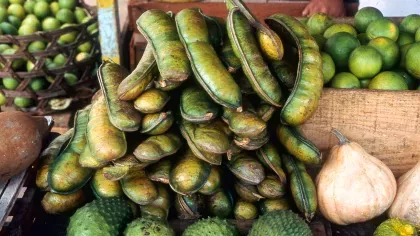1 March 2022
Plants that could tackle vitamin B deficiencies
Kew scientists and partners reveal the staggering array of underused edible plants with potential to address malnutrition for thousands of people.

More than 1,000 plants have been identified as novel sources of B vitamins.
We’ve uncovered a vast array of underused edible species that have the potential to provide global populations with the nutrients they need.
Edible plant diversity
There are at least 7,000 species of edible plants, yet the world depends on just a handful. In fact, around 60% of our calorie intake from plants comes from three crops: wheat, rice and maize.
This over-reliance on a small number of crops is contributing to malnutrition, as well as leaving food systems vulnerable to the effects of climate change.

Around two billion people worldwide suffer with “hidden hunger”, meaning they have an insufficient intake of micronutrients (vitamins and minerals) essential for health.
Hidden hunger often receives less attention than calorie-deficit hunger but can also be detrimental and is not just a problem in low- and middle-income countries, but high-income countries too.
Micronutrient deficiencies lead to a weakened immune system, reduced brain function, blindness and an estimated one million premature deaths each year.
The solution to hidden hunger is not necessarily through increased food intake, but rather through a varied and balanced diet, which can be supported by taking advantage of the rich plant diversity available to us.
However, very few of the thousands of edible plant species found on Earth have had their nutritional contents characterised which hinders their preservation and sustainable use.
In our new paper, published in Nature Plants, we collaborated with scientists from across the UK (RBG Kew, Imperial College London, University of Reading and King’s College London) and the US (Harvard University and Christopher Newport University) to predict the micronutrient profile of underutilised plant species and identify those that could be key sources of vitamins, with a focus on B vitamins.
B vitamins
There are eight different types of vitamin B: thiamine (vitamin B1), riboflavin (vitamin B2), niacin (vitamin B3), pantothenic acid (vitamin B5), pyridoxine (vitamin B6), biotin (vitamin B7), folate (vitamin B9) and vitamin B12.
Generally, B vitamins are important for releasing energy from food, a healthy nervous system, forming red blood cells and preventing birth defects.
Sources of vitamin B include fruits, vegetables, wholegrains, eggs, milk, meat and fish.
Our research specifically looked at six B vitamins – thiamine (B1), riboflavin (B2), niacin (nicotinic acid & nicotinamide, B3), pantothenic acid (B5), pyridoxine (B6) and folate (B9) as these are commonly deficient in low- and high-income countries.
Identifying nutritional plants
We gathered vitamin-B content data for nearly 300 nutritionally-known edible plant species and were able to find that closely related species had very similar nutritional values.
Using this data, we could then predict the vitamin profiles for over 6,400 nutritionally unknown edible species, which allowed us to identify 1,044 species as potential B-vitamin sources.
To gauge the long-term availability of these species for humanity, we also looked at the threat status of each species.
Of the 1,044 species, 63 are threatened with extinction in the wild and need immediate protection before they disappear.
More than 300 species haven’t had their threat status assessed and may be threatened but we just don’t know.
A further 272 species are not currently preserved in seedbanks.
Many of these vulnerable and nutritionally-rich species are found in global hotspots of malnutrition such as South-East Asia and sub-Saharan Africa.
Non-threatened species with potential
Oats
Several oat species (Avena sp) found across Europe and the UK may represent important sources of thiamine (B1). The Ethiopian oat (Avena abyssinica) is also a traditional and underutilised food with high potential for food security.

Legumes
Legumes, the plant group that includes beans, peas and peanuts, are full of a wide range of B vitamins.
They are also extremely diverse and found all around the world. For instance, plant genera such as Vigna (adzuki bean, black gram, cowpea, mung bean), Parkia (twisted cluster bean, tree bean), and Vicia (vetches) are important sources of micronutrients.


Threatened species with potential
Wild durian
Durio kutejensis is a wild species of the “world’s smelliest fruit” Durian.
The species grows in Borneo, Indonesia and is threatened by deforestation and expanding agriculture. It is less sweet than the more commonly cultivated Durian species (Durio zibethinus), and has a more bland flavour.

Baobabs
Fruits and seeds of several emblematic Baobabs (Adansonia), also known as the ‘upside down tree’, endemic from Madagascar may be good sources of folate (vitamin B9).
They are used locally for different purposes, including food but also charcoal and timber, which leads them to be critically endangered.
Mining and agriculture are also major threats. Some species have only a handful of populations left in the wild.

Eradicating hunger
Of course, these B-vitamin-source species should not replace, nor are they more nutritious than, staple crops, but they could be used in a number of applications.
For example, they could be integrated into crop-breeding programmes to enhance the nutritional value of staple crops, a process known as biofortification, or cultivated and harvested by local communities.
When it comes eradicating hidden hunger and achieving the UN’s goal of Zero Hunger, there is no silver bullet but our study has established a unique reservoir of B vitamins and highlighted the crucial need for further conservation action.
Read the paper
Cantwell-Jones, A., Ball, J., Collar, D. et al. (2022) Global plant diversity as a reservoir of micronutrients for humanity. Nat. Plants.




